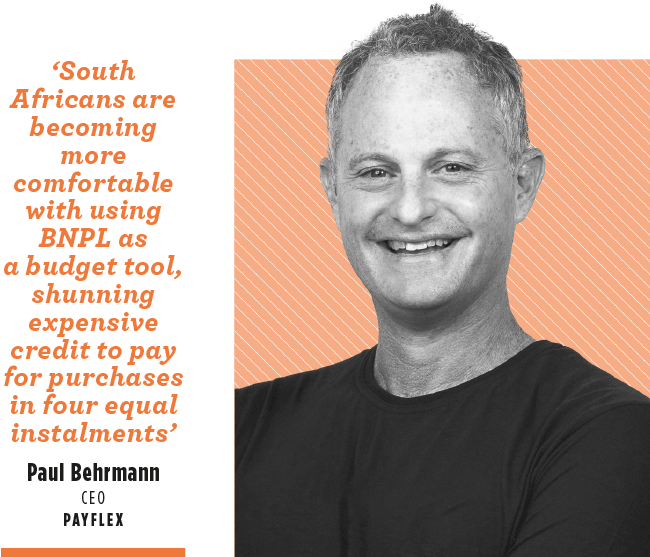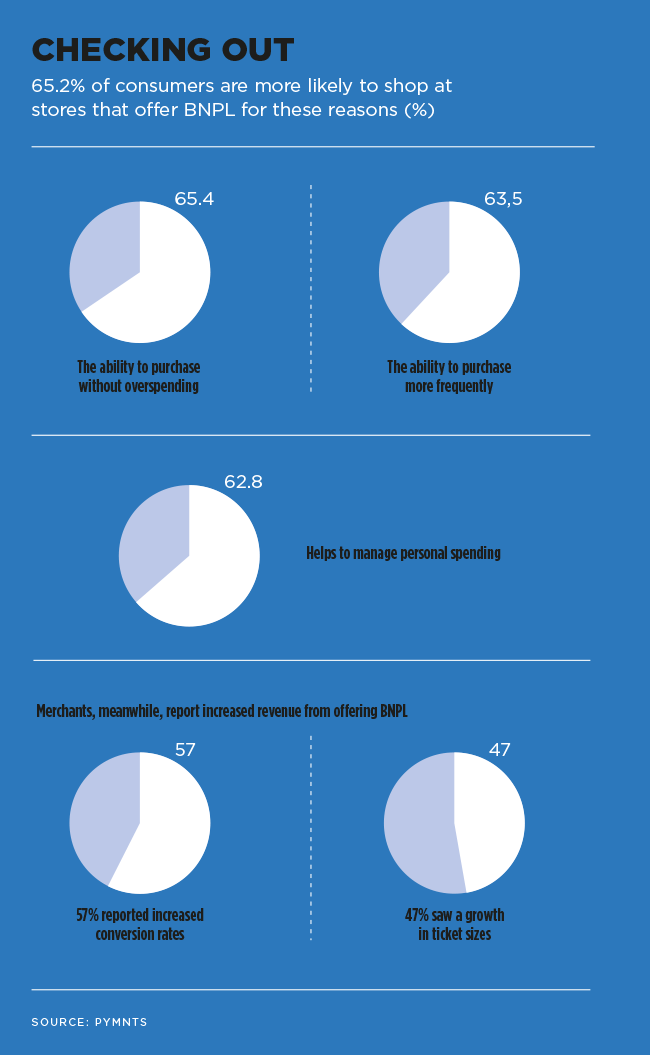In an age of instant gratification, it’s hard to beat the promise of ‘buy now, pay later’ (BNPL). Retailer Game tapped into that promise in the days leading up to November 2022’s Black Friday sales, offering in-store BNPL financing at all 108 of its stores in SA. Game’s offering was at once innovative and nothing new – while BNPL is still an emerging technology, the tough economy is helping in driving its rapid growth.
‘In the wake of the pandemic, while price-awareness among consumers has heightened, inflation is setting curbs on spending,’ YouGov notes in the Future of Financial Services report. ‘This has created favourable circumstances for the adoption of BNPL solutions that allow consumers to pay for products and services in interest-free instalments instead of one- time payments.’
It’s that ‘interest-free’ bit that sets BNPL apart. Consumers have been ‘buying now’ and ‘paying later’ since money was invented through IOUs and various forms of credit card. But those deferred payments have interest baked into the deal. BNPL doesn’t. As BNPL provider Payflex’s marketing copy puts it, ‘it’s essentially similar to the old-school concept of lay-by, but you get the product upfront’.
According to Arun Varughese, head of technology, media and telecoms advisory at RMB, ‘the business model is predicated on a few revenue streams’. In an online post, he explains that BNPL companies charge the merchant a fee (usually 2% to 6% of the total value) for utilising the payment option. ‘In addition, consumers pay late fees if an instalment payment is missed, and there are further opportunities to cross-sell additional financial products. Certain BNPL companies also offer traditional payment options with an interest rate payable as an alternative.’
Payflex introduced BNPL to the SA market at its launch in 2019. ‘Initially, the challenge was getting retailers and consumers to understand the new offering and its benefits,’ says CEO Paul Behrmann. Payflex overcame that by launching with fashion e-tailer Superbalist. It is now offered at more than 2 200 online merchants, and the company claims to have at least 450 000 customers.
‘The real challenge in South Africa is that online potential is limited,’ says Behrmann. ‘Online in the UK is 30%. Australia is 12%. The US is 21% of total retail sales. In South Africa, it’s still only 3% of total retail sales.’
That has forced BNPL providers to move beyond the platform’s e-commerce roots, going in-store to capture more retailers and customers. Payflex, for example, is now in 100 brick-and-mortar stores, with plans to expand that physical footprint. ‘Although current merchants are predominantly retailers, we are looking to expand into other sectors like travel, medical and education where it makes sense to stagger payments for smaller purchases over six weeks,’ he says.
Behrmann points to Payflex’s internal research, which has BNPL growing by 10% to 15% per month in SA, with total BNPL payments estimated to hit around R2 billion by the end of 2022. ‘South Africans are becoming more comfortable with using BNPL as a budget tool, shunning expensive credit to pay for purchases in four equal instalments,’ he says.
‘BNPL is projected by Worldpay to be the world’s fastest-growing payment method between 2021 and 2025. Internationally, large and established financial service companies like Mastercard and Visa are integrating BNPL into their products and South African companies are also incorporating BNPL into their offering.’
If those forecasts seem optimistic, it’s perhaps because of the nature of the market. ‘Adoption of BNPL plans is driven by age, and skews towards the young,’ the YouGov global report notes. ‘Consumers most likely to have made a purchase using a BNPL plan in the last three months fall in the 25 to 34 age group (20%), followed closely by consumers aged 34 to 44 (18%). While younger consumers are likely to be drawn to BNPL plans because of smaller spending capacities, those aged 34 to 44 are increasingly adopting BNPL as inflation hits their spending decisions. Consumers aged 55-plus reported the lowest levels of purchases via BNPL plans (11%).’
Those numbers are consistent with the typical SA profile. Payflex’s average basket size is relatively small at R1 200; while the customer profile matches the demographic of online shoppers, being predominantly 25 to 35 years old with active credit profiles. They are, as Behrmann frames it, ‘young, curious and financially literate’.
Financially literate, yes. Financially responsible? Governments aren’t too sure about that. New Zealand recently announced a proposed regulation that would require BNPL providers to run affordability checks for purchases above NZ$600. Government statistics have BNPL spending in New Zealand growing from NZ$755 million in 2020 to NZ$1.7 billion in 2021, with consumers increasingly using BNPL for more purchases and for higher- value transactions.
However, as Max Chuard, CEO of fintech Temenos, highlights in an op-ed for the WEF, ‘banks are used to regulatory scrutiny in a way that new providers are not. They’re also well capitalised when borrowing costs for new players are increasing. But perhaps the most significant strength banks have is trust from their customers. In fact, 50% of customers prefer BNPL provided by their bank’.
This relationship, he says, gives banks a wealth of customer data. ‘And when this customer data is harnessed by an AI engine that is transparent and explainable, such as Temenos’ patented XAI platform – rather than a “black box” – there is even greater potential to make a positive impact.’
The problem here isn’t the tech itself; it’s the regulatory framework that has yet to catch up with it. As SA personal finance guru Maya Fisher-French explains, ‘BNPL loans fall outside of the National Credit Act as there are no fees or interest, so there are no credit checks. It could be a good solution for people with poor credit records or those who don’t want credit cards or other loans. But BNPL could easily encourage impulse spending. You don’t need to have money now to make the purchase, and paying for it in instalments of a few hundred rands doesn’t feel that onerous, so you are more likely to do it’.
There is a danger, however, that in the wrong hands ‘buy now, pay later’ might become ‘buy now, pay never’. The Payment Association of South Africa has already warned about the rise in unpaid debit orders, as desperate consumers try to manage their cash flows. Products such as Metropolitan GetUp and EasyDebit’s Strike Date Optimisation aim to help companies collect on those outstanding payments – but the risk to businesses remains.
The main causes of business failure are generally related to cash-flow management, says EasyDebit CEO Junior Biola. ‘We know the top reason why start-ups fail is because they run out of cash. In an economy where consumers are increasingly buying now and paying later, debit orders continue to be one of the most used forms of payment. Most unpaid debit orders are due to insufficient funds in the account being debited.’
Closing the payment loop will be vital to getting BNPL to work – both for the buyers and for those who are being paid.










